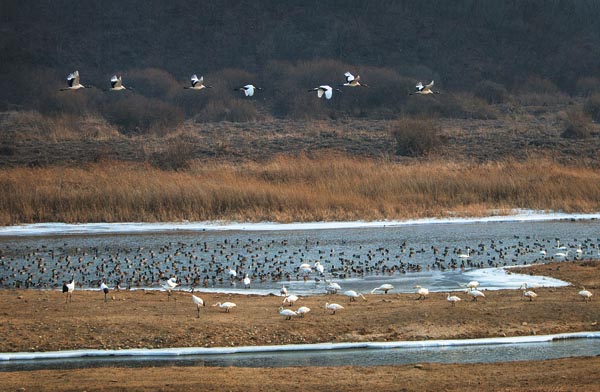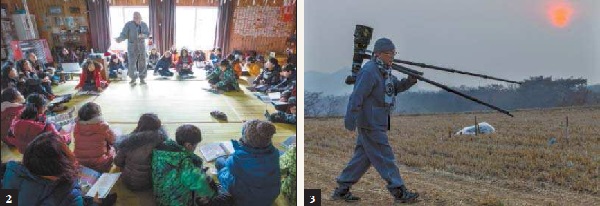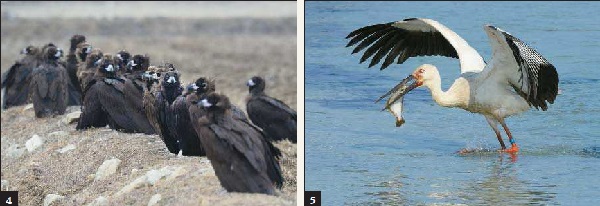[ZOOM KOREA] Monk finds true peace through birds

A bird takes food from the palms of Doyeon Sunim at Doyeon Temple located on the slope of Mount Jijang in Pocheon, Gyeonggi. [PARK SANG-MOON]
They came to hear stories about birds from Doyeon Sunim, a monk at the temple. They listened to every word he said and nodded their heads while he spoke.

Birds including swans and cranes flock to the Hantan River in Cheolwon Country, Gyeonggi, near Doyeon Sunim’s temple. [PARK SANG-MOON]
This is the story of how storks came to live in Korea again, as told by Doyeon Sunim, who loves birds and tries to live like them.
“Storks feed themselves with fish, amphibians and insects in the wetlands and rice paddies,” he continued. “Therefore, if the paddies are polluted, the storks will lose food to eat and finally disappear. In this sense, is it okay for us to eat rice which was produced in paddies without the storks? Humans might repeat the fate of the birds and disappear, won’t we?”
After he introduced the bird, his story went on by reading from a book about ecology, titled “Grandmother and the Storks,” which he wrote.
Doyeon Sunim’s life began not unlike many others in Korea, as he had had a secular job for 10 years after graduating college. However, he decided to quit his job that involved fierce competition and converted to Buddhism.
However, he found being a monk even more difficult: life at the temple was even stricter, more intense and more hierarchical. Later, he realized that such hardship in the temple was not the important part. The temple life had its own essence.

2. Children listen to Doyeon Sunim tell stories at the temple. 3. Doyeon Sunim returns to his temple after taking photographs of birds. [PARK SANG-MOON]
Doyeon Sunim’s philosophy starts with birds. According to him, birds have wings rather than hands, so they live without possession. They are satisfied with daily food. They are not limited by national borders when traveling. They are not obsessed with anything and they are not possessive. He said he realized through birds what non-possession is. In other words, he realized the truth and essence of life through birds.
“The birds taught me the valuable lessons that could not be taught by 8,400 Buddhist writings,” Doyeon Sunim said.
Storks (Natural Monument No. 199) and cranes (Natural Monument No. 202) are his main subjects of interest. Storks are known for their strong familial ties and the cranes are known to be quiet and calm all the time. They are the symbols of a clean environment. They run away from any sign of pesticide, and they can live only when ecological diversity is guaranteed. This means that places where they visit are proven for their ecological safety.

4. Eagles gather in a rice paddy in Cheolwon. 5. A stork catches a fish. [PARK SANG-MOON]
Doyeon Sunim takes pictures of these nonmaterialistic, flying creature in order to show the world their beautiful souls. “Birds sing ceaselessly, telling people to emulate them,” he said. “They always stay by humans and greet us every morning. They tell us not to destroy the environment and throw away trash thoughtlessly. They tell us that we should love each other. I learned all of these lessons from birds. Birds are Buddha.”
BY PARK SANG-MOON [moonpark@joongang.co.kr]










with the Korea JoongAng Daily
To write comments, please log in to one of the accounts.
Standards Board Policy (0/250자)